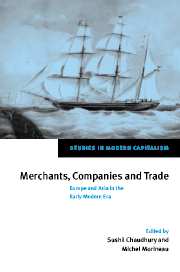Book contents
- Frontmatter
- Contents
- List of contributors
- Preface
- Introduction
- Part I Asia, especially India, around 1500
- Part II Routes, markets and merchants
- Part III European presence in Asia
- 8 The Portuguese and the Dutch in Asian maritime trade: a comparative analysis
- 9 Competition or collaboration? Relations between the Dutch East India Company and Indian merchants around 1680
- 10 The French India Company and its trade in the eighteenth century
- 11 Sweden and India in the eighteenth century: Sweden's difficulty in gaining access to a crowded market
- 12 The ambitions of the Austrian Empire with reference to East India during the last quarter of the eighteenth century
- Part IV Implications of trade: Asia and Europe
- Index
8 - The Portuguese and the Dutch in Asian maritime trade: a comparative analysis
Published online by Cambridge University Press: 02 December 2009
- Frontmatter
- Contents
- List of contributors
- Preface
- Introduction
- Part I Asia, especially India, around 1500
- Part II Routes, markets and merchants
- Part III European presence in Asia
- 8 The Portuguese and the Dutch in Asian maritime trade: a comparative analysis
- 9 Competition or collaboration? Relations between the Dutch East India Company and Indian merchants around 1680
- 10 The French India Company and its trade in the eighteenth century
- 11 Sweden and India in the eighteenth century: Sweden's difficulty in gaining access to a crowded market
- 12 The ambitions of the Austrian Empire with reference to East India during the last quarter of the eighteenth century
- Part IV Implications of trade: Asia and Europe
- Index
Summary
Maritime trade has traditionally been an important component of economic life in Asia. There is evidence to suggest that at least from about the ninth century on, a fairly wide-ranging and sophisticated network of maritime trade had emerged in Asia. This network linked ports in the western Indian Ocean to those in the Bay of Bengal and, via the Malacca Strait, to those in the South China Sea. The Middle East, East Africa, India, South East Asia, China and Japan thus together constituted a major trading zone. India played a central role in this network both in the geographic as well as in a more intrinsic sense. By virtue of her relatively advanced structure of manufacturing production and her capacity to provide large quantities of a basic manufactured consumption good such as inexpensive cotton textiles on highly competitive terms, India significantly enhanced the basis of trade in the Asian continent. She not only made available the textiles and, on a more modest scale, the food grains and the provisions in great demand in the neighbouring societies, but also provided an important outlet for their specialized agricultural, vegetational, mineral and other products. Trade thus satisfied in part different kinds of needs for India as opposed to her trading partners, and this by itself provided an excellent basis for a significant and growing level of trade.
- Type
- Chapter
- Information
- Merchants, Companies and TradeEurope and Asia in the Early Modern Era, pp. 175 - 188Publisher: Cambridge University PressPrint publication year: 1999
- 1
- Cited by



